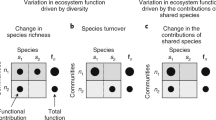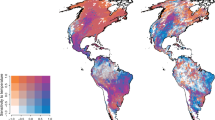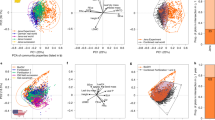Abstract
Links between biodiversity and ecosystem function provide compelling reasons for conserving maximal numbers of species in ecosystems1,2,3,4,5,6. Here we describe a previously unrecognized effect of biodiversity on ecosystem predictability, where predictability is inversely related to temporal and spatial variation in ecosystem properties. By manipulating biodiversity in aquatic microbial communities, we show that one process, ecosystem respiration, becomes more predictable as biodiversity increases. Analysis of similar patterns extracted from other studies2,3,6 indicates that biodiversity also enhances predictability in terrestrial ecosystems. Biodiversity can also affect average levels of ecosystem performance, but the extent to which different species make unique or redundant contributions to ecosystem processes remains controversial3,7,8,9,10. Nonlinear effects of biodiversity on the decomposition of particulate organic matter and resistance of communities to invasion indicate that different species have redundant functions in our system. The consequences of biodiversity are also not restricted to early successional situations as described in previous studies1,2,3,4,6, because strong effects persist even after ecosystems develop for periods corresponding to 40–80 generations of dominant organisms.
This is a preview of subscription content, access via your institution
Access options
Subscribe to this journal
Receive 51 print issues and online access
$199.00 per year
only $3.90 per issue
Buy this article
- Purchase on Springer Link
- Instant access to full article PDF
Prices may be subject to local taxes which are calculated during checkout



Similar content being viewed by others
References
Tilman, D. & Downing, J. A. Biodiversity and stability in grasslands. Nature 367, 363–365 (1994).
Naeem, S., Thompson, L. J., Lawler, S. P., Lawton, J. H. & Woodfin, R. M. Declining biodiversity can alter the performance of ecosystems. Nature 368, 734–737 (1994).
Naeem, S., Thompson, L. J., Lawler, S. P., Lawton, J. H. & Woodfin, R. M. Empirical evidence that declining species diversity may alter the performance of terrestrial ecosystems. Phil. Trans. R. Soc. Lond. 347, 249–262 (1995).
Naeem, S., Hakansson, K., Lawton, J. H., Crawley, M. J. & Thompson, L. J. Biodiversity and plant productivity in a model assemblage of plant species. Oikos 76, 259–264 (1996).
Tilman, D. Biodiversity: population versus ecosystem stability. Ecology 77, 350–363 (1996).
Tilman, D., Wedin, D. & Knops, J. Productivity and sustainability influenced by biodiversity in grassland ecosystems. Nature 379, 718–720 (1996).
Schulze, E. D. & Mooney, H. A. (eds) Biodiversity and Ecosystem Function (Springer, New York, (1993)).
Johnson, K. H., Vogt, K. A., Clark, H. J., Schmitz, O. J. & Vogt, D. J. Biodiversity and the productivity and stability of ecosystems. Trends Ecol. Evol. 11, 372–377 (1996).
Ehrlich, P. R. & Ehrlich, A. H. Extinction. The Causes and Consequences of the Disappearance of Species (Random House, New York, (1981)).
Lawton, J. H. & Brown, V. K. in Biodiversity and Ecosystem Function (eds Schulze, E. D. &Mooney, H. A.) 255–270 (Springer, New York, (1993)).
Pimm, S. L. Properties of food webs. Ecology 61, 219–225 (1980).
Morin, P. J. & Lawler, S. P. Food web architecture and population dynamics: theory and empirical evidence. Annu. Rev. Ecol. Syst. 26, 505–529 (1995).
Tilman, D., Lehman, C. L. & Thompson, K. T. Plant diversity and ecosystem productivity: theoretical considerations. Proc. Natl Acad. Sci. USA 94, 1857–1861 (1997).
Pimm, S. L. in Biological Invasions: A Global Perspective (ed Drake, J. A. et al.) 351–367 (Wiley, New York, (1989)).
Pimm, S. L. The Balance of Nature? (Univ. Chicago Press, Chicago, (1991)).
Tilman, D. Community invasibility, recruitment limitation, and grassland biodiversity. Ecology 78, 81–92 (1997).
Case, T. J. Invasion resistance arises in strongly interacting species-rich model competition communities. Proc. Natl Acad. Sci. USA 87, 9610–9614 (1990).
Elton, C. S. The Ecology of Invasions by Plants and Animals (Chapman and Hall, London, (1958)).
Vitousek, P. M. Biological invasions and ecosystem processes: towards an integration of population biology and ecosystem studies. Oikos 57, 7–13 (1990).
Karieva & P. M., Kingsolver, J. G. & Huey, R. B. (eds) Biotic Interactions and Global Change (Sinauer, Sunderland, Massachusetts, (1993)).
Acknowledgements
We thank the NSF for supporting our research, and J. H. Lawton, D. Tilman, S.Naeem, S. Lawler, M. Holyoak, P. Steed and T. Casey for their comments.
Author information
Authors and Affiliations
Corresponding author
Rights and permissions
About this article
Cite this article
McGrady-Steed, J., Harris, P. & Morin, P. Biodiversity regulates ecosystem predictability. Nature 390, 162–165 (1997). https://doi.org/10.1038/36561
Received:
Accepted:
Issue Date:
DOI: https://doi.org/10.1038/36561
This article is cited by
-
Predator interference and complexity–stability in food webs
Scientific Reports (2022)
-
Analysis on the stability of plankton in a food web with empirical organism body mass distribution
Environmental Science and Pollution Research (2022)
-
Forest Certification in the Context of the Functional Complex Network Approach for Forest Management
Current Landscape Ecology Reports (2022)
-
Competition alters species’ plastic and genetic response to environmental change
Scientific Reports (2021)
-
Fine-scale succession patterns and assembly mechanisms of bacterial community of Litopenaeus vannamei larvae across the developmental cycle
Microbiome (2020)
Comments
By submitting a comment you agree to abide by our Terms and Community Guidelines. If you find something abusive or that does not comply with our terms or guidelines please flag it as inappropriate.



